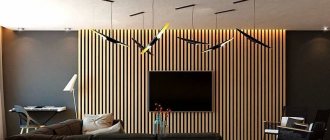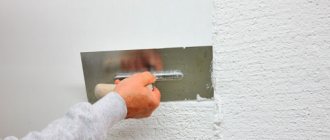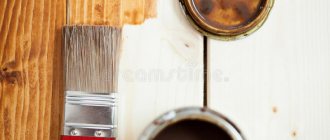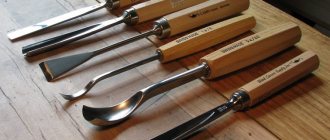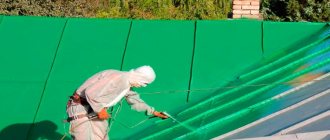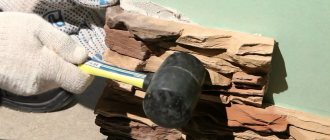SHARE ON SOCIAL NETWORKS
FacebookTwitterOkGoogle+PinterestVk
Beitz is not just one type of coloring composition. This is a product that breathes life into old furniture, stairs, floors, doors and window sills that have long lost their presentable appearance. From this article you can find out what tinting abilities wood stain has: colors used to create an exotic interior, shades that imitate expensive species, as well as interesting combinations that allow you to achieve beautiful effects.
Stain is a tinting mixture that can be used to give any wood product the desired shade.
Features and color characteristics
Oak takes on darker colors over the years. Obtaining a variety of color options is possible through the use of various technologies. Tones can be cold or warm, the brightness of the structure can also be adjusted. There is wood with a natural color that is close to black. To recognize the oak, you should take a closer look at the picture.
Obtaining a variety of color options is possible through the use of various technologies.
Oak colors and shades
The color palette of the material is large. There are very light options and black ones. This diversity is possible due to the use of different material processing techniques. Modern technologies help to obtain a large number of color solutions.
Modern technologies help to obtain a large number of color solutions.
Whitened or bleached oak
White oak cannot be found in nature, although in the production of furniture they often resort to obtaining this color scheme. The oak itself has a darker color, even if we are talking about young trees, by the way, they are not chosen for production.
To create a similar effect, they resort to treating the material with chemicals. Next comes soaking it in oil and applying varnish.
To create a similar effect, they resort to treating the material with chemicals.
Golden oak
Oak wood is distinguished by its straw color, which helps to obtain, by slightly staining, a golden color. In nature, such coloring can occur under the influence of sun, wind and water.
Oak wood is distinguished by its straw color, which helps to obtain, by slightly staining, a golden color.
Dark oak
The natural dark shade is characteristic of a number of wood species, usually found in Europe. Also, a similar effect occurs when a tree sits in water for a long time; such wood is considered valuable. They call it “moraine”, we are talking about a hundred-year period.
A similar effect occurs when a tree sits in water for a long time; such wood is considered valuable.
Black oak
The most expensive is bog oak, which has lain in water for more than a thousand years. Such conditions lead to superior strength characteristics. The wood also acquires a black color, which looks luxurious and presentable.
The most expensive is bog oak, which has lain in water for more than a thousand years.
Examples of interiors in wenge color
In the dining room and kitchen, it is better to use a classic scheme, according to which dark shades are given a place below head level. In this case, the room will seem more spacious. In addition, dark brown has a relaxing effect, which is not entirely appropriate in the kitchen, where the housewife needs a lively mood for preparing holiday dishes.
Wood tones are not necessarily present in furniture and flooring. Wenge can find a place for itself on the ceiling in the form of a tier of a multi-level ceiling. This solution is quite suitable for high walls. In this case, black wall cabinets are hidden, creating a niche effect, and do not compete with the nobility of the African guest.
What to do if you want dark brown walls? Maintain this shade in the chandelier, chandelier and tabletops. Decorate the walls and floor in creamy tones. Decorative accents of red, burgundy, and green are allowed.
Can wenge make friends with toffee? Yes, if you mix it with golden veins. A dark shade will emphasize the depth of the niche in the kitchen set. And so that he does not feel lonely, we will give him a door, a chandelier and lamps as companions. The chocolate napkins are the icing on this cake.
I really want tsavo, but the kitchen is small. And the hostess likes there to be a lot of light and space. What to do?
The solution is actually very simple. Order a white set with a horizontal contrasting stripe on the fronts of the wall cabinets. If you want even more contrast, use the same shade in the fronts of the lower cabinets. At the same time, white or steel narrow stripes will create movement dynamics. An excellent solution for modernity.
To relieve the feeling of hospital sterility, lay cocoa-and-milk colored tiles on the floor.
Wenge is a great place for creative ideas. At the same time, this color loves to be surrounded by milky and creamy tones interspersed with natural pink, purple, red and yellow shades. Create exquisite interiors that are characterized by luxurious simplicity and VIP class elegance.
Bathroom decoration
Wood in the bathroom interior creates the feeling of a sauna or Russian bath. Wooden walls and stone floors, or vice versa, create a unique design. To finish the bathroom, you need to select moisture-resistant species (Brazil walnut or bamboo, as in the photo below).
For a bathroom in an apartment, you can use wood-look tiles, wooden accessories and inserts.
Application methods
There are four main ways to apply stain:
- Rubbing painting. The composition is applied to the surface, after which it is rubbed over the entire area. Recommended for use when processing porous wood species.
- Sputtering. When staining wood by spraying, a manual or automatic sprayer is used as a tool for applying stain.
- Processing with a foam roller. This method avoids the formation of streaks and helps to distribute the mixture evenly over the entire surface.
- Processing wood with a paint brush. The method allows you to obtain a deeper and richer color of wood, but is not suitable for all types of impregnation.
- Before painting a surface with stain, it is necessary to remove old coatings from it, and then degrease it better.
- The surface made of coniferous species (for example, pine) must be deresined.
- It is necessary to paint wood with stain and remove excess only in the direction of the wood structure.
- It is recommended to cover the surface with 2-3 layers, while for the first layer a small volume of the mixture should be used.
- After the first layer has dried, the surface must be sanded and the raised lint removed, and then, if necessary, apply subsequent layers (each subsequent layer is applied only after the previous one has completely dried).
The approximate drying time for oil-based impregnations is about three days, and for water-based and solvent impregnations - 2-3 hours (depending on how many layers were applied). It is recommended to divide large areas of the surface to be treated into small areas and paint them in stages. To avoid the possibility of defects forming on the surface, the composition must be diluted. A solvent is used for this.
Plywood stains perform a purely decorative function. Therefore, if you are in doubt about whether to choose stain or varnish, it is recommended to use them in combination. Before covering the surface of the plywood, it must be moistened, and it is recommended to heat the mixture itself.
After covering the wood with stain, it should be treated with varnish (layers should be very thin to avoid the possibility of smudges). The tool you can use is a brush, roller or sponge. Wood varnish will enhance the protective properties of the impregnation. By following these recommendations, you can easily stain wood at home.
Adviсe
The method of application depends on the type of stain and the size of the product. For these purposes, use a swab, brush or paint spray. To treat a large surface, it is not recommended to use a brush, since there is a high probability that traces of its bristles will remain, and it will also take a lot of time to process.
It is more convenient to work with a large area using a sprayer. To do this, you need to choose an impregnation of a lighter shade, since the applied layer will be thicker than usual. When starting work, do not forget to cover the untreated surfaces with film.
If you still want to apply the composition with a brush, then for water- and alcohol-based stains you need to choose a brush with synthetic bristles. It is necessary to buy only a high-quality tool that will not leave lint on the wood.
After selecting the appropriate shade and tool, it is necessary to carry out a test painting. This is done in order to find out the required number of layers of stain to obtain a specific shade. To do this you need:
- take a small sample of wooden material of the same type as the product to be painted;
- sand the board in the same way as the main product;
- cover it with impregnation and leave to dry;
- apply the next layer to two-thirds of the wood;
- when the last layer has dried, apply stain to the remaining one-third of the board;
- compare color saturation and choose the optimal shade.
The stain is applied to an uncoated wooden surface: it can be a completely new product or a part from which the previous coating has been removed.
Dry wood needs sanding with sandpaper. While working, you cannot press hard on the wood; you only need to move along the grain. This will avoid the appearance of small defects on the surface. If before painting they are almost invisible, then after treatment with impregnation the defects will be greatly emphasized. The sanding process takes about 30 minutes, this is enough to obtain a smooth surface and open the pores for the stain to penetrate.
After sanding, it is necessary to remove fibers and dust from the product with a vacuum cleaner. Using white spirit or gasoline, degrease the surface of the part. At the end, you should spray the wood with water, so the impregnation will apply correctly. To ensure uniform mixing of the contents, the jars are thoroughly shaken. Then you need to heat the stain to average body temperature, so the composition penetrates deeper into the wood structure, then moisten the brush or swab for painting in the impregnation. For a sprayer, pour the stain into a special container.
During processing of vertical products, they move from bottom to top. If the composition drains, the smudges will remain almost unnoticeable. To process horizontally, move the brush along the fibers, then across, and then again along
It is important to distribute the stain carefully and ensure even application. To avoid streaks, apply the composition as quickly as possible
Before applying the second layer of stain, it is imperative that the initial layer dry completely.
After the composition has completely dried on the surface, the final wood processing process is carried out. Washing removes excess impregnation that remains without being absorbed into the surface. After this process, the product looks different: shine and texture appear. Washing is carried out with acetone using a volumetric brush as follows:
- tilt the product slightly;
- absorbent fabric is placed under it;
- dip the brush into the liquid;
- move the brush from top to bottom to drain excess impregnation;
- continue actions until the surface becomes homogeneous;
- leave the products to dry and then apply varnish.
To learn how to make wood stain with your own hands, watch the following video.
Varieties
You can cover absolutely any wood surface with stains - pine, oak, maple, birch and so on. But you still need to know the types of this product, because each type of stain has certain properties.
Water
The presence of water in the composition of the stain is considered the main constituent ingredient. The group of water-based impregnations is considered the largest. Typically, these products are prepared in finished form or in powder form. The powder can be diluted in water independently according to the attached instructions.
Positive traits:
- Due to the fact that this product has a neutral base, it does not have increased toxicity and does not have any harmful effects on health;
- Availability of a wide range of shades with natural texture. Using these types of products, you can create shades from the lightest to deepest, which will help recreate a natural look and deepen the tone. This quality also gives the surface an expressive and noble appearance;
- It is easy and simple to apply, with minimal product consumption;
- Suitable for any type of wood - pine, birch, oak, maple, walnut, cherry;
- Not high cost.
Alcohol type stain
This product is available in the form of aniline dye, which is dissolved in denatured alcohol. This type of stain is sold both ready-made and dry in powder form, which must be dissolved.
This product has the advantage of drying quickly. However, this quality provides some qualities when manually applying the mixture to wood; after drying, greasy stains often form. Therefore, many builders recommend using a spray gun when using alcohol products.
Oily
In these products, all oil pigments are dissolved in solvents or White Spirit. This composition provides a number of advantages to this type of stain:
- When painting, it provides tinting of wooden surfaces in various colors;
- Oil mixtures are convenient to use at home;
- The composition adheres well to the surface and can be applied with any tools;
- The oil stain evenly enters the area of the wood structure, while forming a protective film on the surface.
Acrylic and wax
Wood stain, which is made from an acrylic or wax base, is new to the construction market. This product has proven itself positively among many consumers and professional builders. This is due to the fact that this mixture, after application, creates high protection for the base from negative influences and premature wear.
Features of the composition:
- After application, this type of impregnation forms an insulating film on the surface of the wood, through which moisture and other negative substances do not penetrate;
- Various color characteristics. Compared to other varieties, this composition has a variety of colors from natural to bright exotic tones;
- These types of stains are used by many modern furniture designers. These products are used to paint the external facades of cabinets, tables, and chairs made of different types of wood.
With whitening effect
It is not always necessary that the wood be dark in color; sometimes it is required that, on the contrary, it have a slightly whitish color. In these cases, impregnations based on hydrogen peroxide and acids are suitable. With their help you can get a light, bleached color of wooden beams. Typically, these solutions are used to prepare the surface for further painting.
Stain is simply a necessary thing to improve the quality of wood. This product protects the base from rapid wear and destruction. The main thing is to choose the right product and carefully read the instructions and characteristics of the composition. But which mixtures to choose all depend on what they will be used for - to improve color or for protection. It is better to first study the properties of each type of stain.
Flow calculation
The main indicator that must be taken into account when calculating consumption is the degree of porosity of the base material. Any stain has excellent absorbency. On average, one liter of composition is required per 15 m2. It is also important to consider the intensity of the shade. Conifers have low absorbency, so they will need to be processed in several layers to achieve the desired pattern, which will at least double the consumption.
The amount of material used is affected by the shape of the surface to be painted, the presence of corner locks, and hard-to-reach places. On each container of the mixture, manufacturers indicate how much mixture must be used to obtain a certain pattern. The exception is oil compositions, the task of which is to saturate the wood until the pores are completely filled. In this case, the type of tree and its condition are taken into account.
To reduce stain consumption when painting coniferous wood, it is necessary to remove tree resin from the base in advance.
Colors and effects
Stain is used to treat wooden surfaces. When it is mentioned, a brown surface immediately appears. For many consumers, this color seems to be the most relevant. Having studied the features of the product and its color range, it becomes clear that this product has a wide variety, which allows you to give the interior a new and unique look. Thanks to the wide variety of assortments, any colors and shades can be selected.
When choosing a color, you should be guided by the fact that the composition will appear differently on different surfaces. Even if the samples presented in the store show a certain color, it is better to first test it at home on a small area of the surface being treated and make sure that the tone matches. Although the manufacturer indicates the tone on the packaging, the color may appear differently on different surfaces, as natural materials absorb the composition and acquire completely new shades.
By treating the surface with water or alcohol stains, you can achieve a natural effect. When choosing a product, you should consider what effect you plan to achieve. You can improve a room in a matter of hours by applying oak or ebony color to the surface. Mahogany will look redder after treatment, while maple, due to its density, will hardly change color when applied.
When applied to the porous surface of poplar, its color will change. The oak will have a distinct pattern due to its structure. Often neutral tones are chosen for processing. You can choose dark shades and take the color of mocha, walnut, mahogany or cognac.
Treatment products for wooden surfaces come in a wide variety of colors, making the old coating immediately more interesting. Surfaces treated with oak, beech, cherry and teak stains are original.
Not only store-bought stains are used to treat wood; the surface can be treated with products obtained from plants.
- Larch is suitable for giving products a red tint; a decoction of its bark will help achieve this effect. The tree will become redder if you cover it with a decoction of onion peels.
- Ground walnut shells will help you achieve unusual shades. The powder is boiled and soda is added at the end of cooking. When fringe is added, a rich reddish tone is obtained. If you add acetic acid, the color will turn gray.
- When using walnut powder and apple tree bark, you can achieve a brown color; when adding alum, the color will become dark brown.
- When applying a decoction of unripe buckthorn fruits, you can get a golden hue.
You can achieve a varied color palette and get an interesting rich color, such as wenge, Oregon, pine or a stain like stained oak, black, using stains based on tea, coffee and vinegar.
- The use of coffee allows you to achieve a brown tint. Coffee beans should be ground and baking soda added, or instant coffee should be made and applied to the surface.
- You can add a dark brown color using regular tea leaves. The strength of the brew affects the color saturation.
- The ebony effect can be achieved using metal and vinegar. To do this, metal products are poured for at least 2 days and left in a well-ventilated place.
- To give the product cherry shades, potassium permanganate is used. After treatment with potassium permanganate, at the rate of 50 g per 1 liter of water, the surface is varnished so that the material does not fade in the sun.
The color palette is so diverse that it is difficult to decide which color to take. You can stick to neutral shades or choose a colorless option. The color palette allows you to use unusual shades: yellow, green, orange, emerald green. Blue stain, white or blue - this is not a complete list of colors for updating wooden surfaces.
Kinds
Depending on the material that is the basis of the composition, several types of stain are distinguished.
One of the most common types is aquatic. This product is available on the shelves of hardware stores in two versions:
- dry;
- liquid
The first is a powder for dilution with water. It must be strained before use. Otherwise, particles of undissolved pigment will prevent you from applying the product in an even layer. The second option is a ready-to-use liquid, poured into various containers.
Water stain is economical, does not require special skills during application, and is inexpensive. Its advantage is non-toxicity and absence of unpleasant odor. It is ideal for interior work. The treated surface will dry in just over 12 hours.
Be sure to take into account the peculiarities of such finishing material. Penetrating deep, it lifts the wood fibers. Due to this, the product acquires a spectacular natural look. However, this impact is negative and shortens the life of the wooden covering. The problem can be dealt with if, before applying the composition, treat the wood with water and after a day clean it with an emery cloth.
Alcohol stain is also sold in dry or liquid form. To dilute the powder, ethyl alcohol is used. The peculiarity of this composition is quick drying. Therefore, it is often used for working with wood outdoors. If you need to process the product indoors, good ventilation is necessary, since the stain has a specific pungent odor.
The base of oil stain is usually linseed oil. White spirit is used for dilution. This composition allows you to paint wooden surfaces in a variety of shades. The stain is easy to apply, penetrating deep into the wood and protecting it from moisture. In this case, you can use a brush, as it does not leave streaks. The only drawback is that it takes a long time to dry.
Wax stains are environmentally friendly and safe for human health. This determines their high cost. They can be used not only for painting wooden surfaces. They can restore or correct errors in wood flooring.
The thickest type of stain is gels. They are applied to soft wood surfaces. It is difficult to distribute this composition with a brush, so special tampons are used. Mainly, gels are used for outdoor work. They will “revive” benches and gazebos in the garden and add uniqueness to the façade and fence.
Acrylic stains are based on resins. The product is an emulsion. It is easy to apply. Penetrating deeply enough, the composition protects the surface from the negative effects of moisture. A diverse range of shades will allow you to bring all your most secret ideas into reality. At the same time, the processed product will not fade under the sun's rays and will retain its color saturation for a long time. Acrylic stains are economical, but expensive.
A special type of stain is stain. It is based on organic solvents, dyes and pigments. The stain dries quickly and gives an even shade that is resistant to fading.
Hydrogen peroxide or acid is the basis for whitening stains. This composition is designed to make the wooden surface lighter for further processing or painting.
Features of wood stain: what is it for and what properties does it have?
Wood is distinguished by its natural beauty and warmth, environmental friendliness and the ability to create comfort around itself. To preserve all these properties of the material and extend its service life, special means are used, including stains.
Thanks to stain, you can significantly extend the life of wood products
These compounds improve the decorative qualities of wood, and also provide reliable protection against various pests and the negative effects of environmental factors. Before you start choosing the right option, you need to understand what stain is and what its purpose is.
Stain (stain) is a special product intended for wood processing. Most often, the composition is sold in liquid form, but in rare cases it can be in the form of a dry powder. Mostly dark stain. It is used to give wood various translucent shades. At the same time, the texture of the material and its natural pattern do not change at all, since the product penetrates only into the top layer. Stain emphasizes the natural beauty of wood and enhances its attractive aspects.
This tool allows you not only to change the appearance of the material, but also to protect it from the destructive effects of external factors. It is the versatility of the stain that has made it so popular.
Stain (also called stain) can give wood different shades
Why do you need wood stain? This composition is used in the following cases:
- Toning a material while maintaining its texture and wood pattern - the composition lifts the fibers of the material without radically changing its natural pattern.
- Wood bleaching - this property is used in the process of restoration and restoration of damaged and old products made of wood. Such stains are also used in cases where it is necessary to make the shade of the material lighter or to prepare its surface for colored varnishing.
- Imitation of elite wood species on budget materials.
- Protecting the material from damage by parasites - the antiseptic properties of the stain prevent the development of putrefactive processes (elimination of fungi, bacteria and mold) and the proliferation of insect pests.
- Strengthening the structure of the material.
- Moisture protection of wood - stain protects the material from the negative effects of moisture, and some types of compositions create a water-repellent layer on the surface (partially).
- Extending the service life of wood products.
- Creating a finishing effect using different types of wood by combining shades.
Varnish protects wood from aggressive weather influences
Drying oil has similar properties, but after processing a film forms on the surface of the wood. This product is not able to penetrate deeply into the pores of the material, but it covers them well from the outside. Unlike stain, drying oil cannot be used as an independent finishing agent. It is intended for preparing wood before painting.
Wood varnish is very different from stain. It forms a stable film on the surface of the material. Moreover, the formation of the protective layer occurs only after the solvent contained in its composition has completely evaporated. After drying, oil-based varnishes form a film on the surface that is durable and elastic. This coating is quite difficult to remove even with white spirit.
Like any other finishing option, the varnish will have to be renewed periodically, and for this it is necessary to remove the previous layer. This requires some effort, so varnish is used in cases where the impact of atmospheric factors on wood is too aggressive and the use of stain is impractical.
Drying oil is similar to stain, but is not used as an independent coating
Decor made of wooden elements
Due to their strength and unusual beauty, wooden ends have long been popular among craftsmen. Each layer stores history, mood and nature. In addition to all this, material for the ends surrounds us everywhere; crooked branches, thickenings on tree trunks, cracks, knots, etc. become especially interesting. You just have to give free rein to your imagination and emotions.
Decorative lamps, vases, hangers, tables made of wood elements are very relevant today. They, in combination with modern design solutions, are able to fill the atmosphere of the home with comfort, luxury and warmth at the same time.
Dead stumps, branches, trunks and roots in the hands of an artist can become a masterpiece that will decorate the interior, filling it with natural simplicity and harmony.
Tinting effects
Depending on the palette of shades used, the type of stain and the desire of the craftsman, you can give the wood a variety of effects. Due to the latter, design possibilities are greatly expanded.
Whitening process
White color is very popular in the interior. In addition, with the help of bleaching, you can restore the normal appearance of old wood, which has lost its attractiveness, but has acquired dark, bluish spots. You can also decorate some interior elements, for example, cover photo frames and paintings with bleaching stain.
Embossed white products that have been treated with special brushes look beautiful (this removes too soft fibers). After finishing the processing, they are covered with a white, light walnut stain. To protect the wood from the influence of atmospheric factors, you can apply white wax on top.
Aging of wood
An interesting option for finishing wood is to give it an aged effect. First, the product must be prepared: remove dirt, sand it, brush off dust. Then a water-based stain in white or another light color is applied to the wood. The freshly applied mixture is removed from some areas with strokes using a sponge. After drying, a finishing coat based on organic solvents is required, and to fix the shade, the pores are filled with shellac primer or wood varnish.
In addition to this method of making wood look old, there is another popular method. First you need to apply white stain, after drying, sand the product, then gently rub in dark wax. This will enhance the impression of great “age” of the coating and bring it closer to the “bleached oak” shade.
Imitation ebony
For this purpose, dark stains are used, which are marked accordingly. The wood is first sanded and polished to achieve maximum aesthetic effect. Then the stain is applied, performing one or two layers. In order for the surface to resemble a black mirror with knots appearing, you need to choose the hardest, most dense, finely porous rocks.
Giving other shades
Depending on the style, features of the interior or landscape, you can give wooden structures a variety of colors
It is only important that they all fit well with each other and do not conflict. The most commonly used non-wood shades are:
- blue - sometimes used as the main coating of finished products, pieces of furniture, gives them a very expressive look, goes well with white and yellow tones;
- gray – used in combination with bright accents, otherwise the product will turn out faceless; if there is an abundance of gray in the interior, there is a risk of depression;
- red – helps to highlight one or more elements from the total mass.
Some people try to save money and paint the wood themselves. Instead of stain, onion peels, alum, infusion of walnuts and other “folk remedies” are used. Unfortunately, the effect is rarely lasting, so it is better to purchase a high-quality composition that will last a long time and without complaints.
Living room decoration
Wood in the living room interior always looks very impressive and is appropriate in almost any design. If this is a Scandinavian style, then the use of light woods emphasizes the connection with nature; wooden furniture in pastel shades is suitable for Provence. Small and simple wooden details are appropriate in minimalism and hi-tech.
Stumps and large saw cuts in the interior of the living room can play the role of a coffee table and become the main focus of attention of guests. You can make an accent wall near the TV from saw cuts and pebbles; from processed sticks and branches you can make a cornice, lamp and other accessories.
